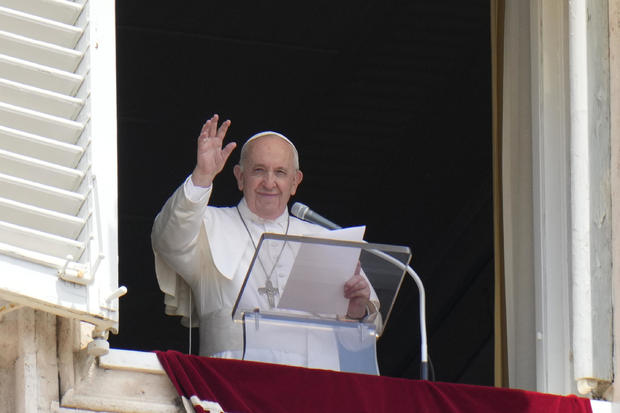Pope Francis goes to Rome hospital for planned intestinal surgery
Good Monday #GoodMonday

Vatican City — Pope Francis was in good condition, alert and breathing on his own Monday after undergoing successful surgery over the weekend to have part of his lower intestine removed, the Vatican said. In a statement issued on Monday, the Holy See press office said the 84-year-old Francis was likely to remain hospitalized for about a week following his surgery on Sunday evening.
He was placed under general anesthesia for the roughly three-hour hemicolectomy — the surgical removal of part of the lower intestine — which was necessitated by a narrowing of the intestine.
“His Holiness Pope Francis is in good general condition, alert and spontaneously breathing,” the Holy See press office statement said on Monday.
 In this Sunday, July 4, 2021 file photo, Pope Francis waves to the crowd from the window of his studio overlooking St. Peter’s Square at the Vatican. Alessandra Tarantino / AP
In this Sunday, July 4, 2021 file photo, Pope Francis waves to the crowd from the window of his studio overlooking St. Peter’s Square at the Vatican. Alessandra Tarantino / AP
The pope was admitted on Sunday for treatment of a diverticular stenosis, the abnormal constriction or narrowing of the lower intestine. The sigmoid portion of the large intestine extends from the end of the descending colon to the rectum. Gastroenterologists say the sigmoid segment is a common location for a stenosis.
The main surgeon was Dr. Sergio Alfieri, the director of digestive surgery at Rome’s Agostino Gemelli Polyclinic, a Catholic hospital.
Among those present in the operating room was the official papal physician, whom Francis tapped earlier this year. The pope’s previous physician had contracted COVID-19 and died at Gemelli while hospitalized for cancer treatment.
It was a remarkable end to a day that began publicly for Francis when, during his traditional Sunday appearance to the faithful in St. Peter’s Square, he cheerfully announced he would go to Hungary and Slovakia in September.
Trending News
The pope made no mention of his impending surgery, but headed shortly after his window appearance to the hospital. At the end of his public remarks from an Apostolic Palace window, Francis told the crowd: “And please, don’t forget to pray for me.” Then he added, sounding casual, almost wistfully: “Thanks, ciao.”
A couple hours after he was admitted to the hospital, reportedly arriving with little escort and no fanfare, the Vatican revealed Francis’ diagnosis. A week earlier, Francis had used his same Sunday appearance to ask the public for special prayers for himself, which may have been related to the planned surgery.
“I ask you to pray for the pope, pray in a special way,” Francis had asked the faithful in the square on June 27. “The pope needs your prayers,” he said, adding his thanks and saying “I know you will do that.”
Francis is in generally good health, but he did have part of one lung removed as a young man. He also suffers from sciatica, in which a nerve affects the lower back and leg, a painful condition that has forced him at times to skip scheduled appearances.
The pope had a particularly demanding set of appointments last week, including celebrating a Mass on Tuesday to mark the Catholic feast day honoring Saints Peter and Paul, and later in the week, presiding at a special prayer service for Lebanon. On June 28, he also had a long private audience at the Vatican with U.S. Secretary of State Antony Blinken. Throughout all those engagements, Francis appeared to be in good spirits.
Get-well wishes began arriving immediately for Francis. Italian President Sergio Mattarella, as soon as he landed in Paris for a state visit in France, offered an “affectionate thought” on behalf of all Italians. Mattarella said he was wishing for “a good convalescence and even a speedier recovery” for the pope.
Gemelli doctors have performed surgery before on popes, notably Pope John Paul II, who had what the Vatican said was a benign tumor in his colon removed in 1992. John Paul had several other surgeries at the hospital, including after being shot by a gunman in St. Peter’s Square in 1981.
John Paul also had several medical issues in his final years, including severe complications from Parkinson’s disease, and had numerous stays at Gemelli. At one point, the future St. John Paul II dubbed the hospital “the third Vatican,” after Vatican City and the papal summer residence at Castel Gandolfo outside Rome.